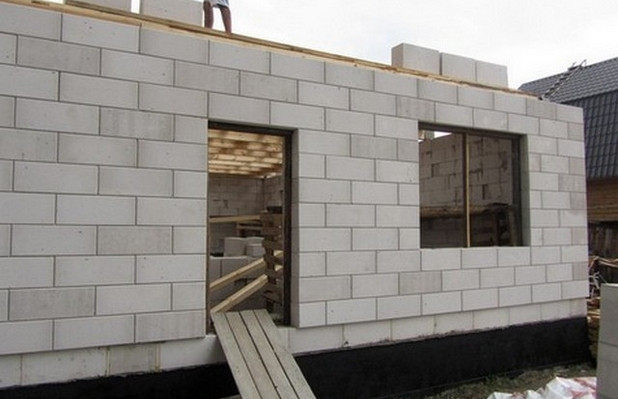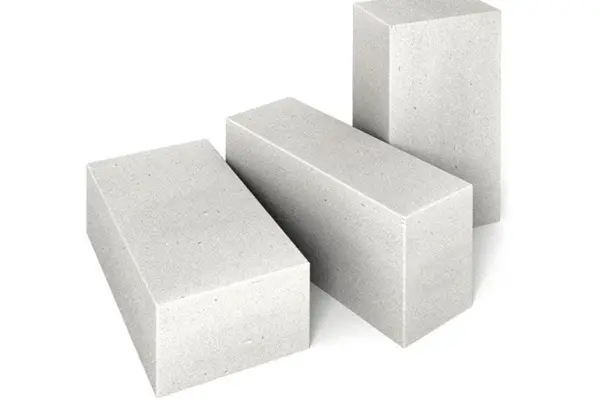Choosing between Foamed Concrete and Autoclaved Aerated Concrete (AAC) is one of the first important decisions that future homeowners face. Building a house from quality cellular concrete will cost approximately $350-500 per square meter. Each of these materials has special technical characteristics that affect the quality and durability of the future structure. By the way, the differences between them are not always obvious even to professionals, which often leads to confusion during the design process.
Cellular concretes appeared in construction almost a century ago. Foamed Concrete was invented in Germany in the 1920s, although mass production only began in the 1940s. Autoclaved Aerated Concrete (AAC) was first created in Sweden in 1929 under the Siporex brand. Not always simple. But effective.
Differences Between Foamed Concrete and AAC: Key Characteristics
 The main difference between Foamed Concrete and AAC is the pore structure and production technology. A comparison of AAC blocks and CLC blocks shows a fundamental difference in their composition. In my experience, after working with both materials for the past three years, I've noticed that AAC has a more homogeneous structure and precise block geometry.
The main difference between Foamed Concrete and AAC is the pore structure and production technology. A comparison of AAC blocks and CLC blocks shows a fundamental difference in their composition. In my experience, after working with both materials for the past three years, I've noticed that AAC has a more homogeneous structure and precise block geometry.
Professor of Construction Technologies James Holt states: "Cellular concretes have completely changed the approach to thermally efficient construction. When properly applied, they can reduce heating costs by up to 40% compared to traditional materials, and the service life of such buildings, when technology is followed, is at least 60-80 years."
AAC is produced exclusively in industrial conditions using autoclaving, which makes it stronger than Foamed Concrete at the same density. Sounds complicated? In reality, it's simply a process of baking blocks under pressure. The production technology of Foamed Concrete involves adding a foaming agent to a cement-sand mixture. This process can be carried out even at a construction site, but this significantly reduces the geometric accuracy — the error can reach up to 3 cm.
Technical Characteristics of AAC and Foamed Concrete in Comparison
The choice between Foamed Concrete and AAC often depends on comparing their technical parameters. They differ in weight. Honestly, both materials have advantages and disadvantages. At the same strength grade, AAC blocks are usually lighter and warmer than CLC blocks. Last season, I encountered a situation where a house made of D500 grade AAC was 15% warmer than a similar structure made of D600 Foamed Concrete.
| Characteristic | Foamed Concrete | AAC |
|---|---|---|
| Average density (kg/m³) | 300-1200 | 300-700 |
| Compressive strength (MPa) | 0.4-5.0 (B1.0-B3.5) | 1.5-7.5 (B2.0-B5.0) |
| Thermal conductivity (W/m·°C) | 0.08-0.38 | 0.07-0.22 |
| Water absorption (%) | up to 15 | up to 30 |
| Frost resistance (cycles) | F15-F50 | F25-F100 |
| Shrinkage when drying (mm/m) | 1.0-3.0 | 0.3-0.5 |
| Vapor permeability (mg/m·h·Pa) | 0.11-0.17 | 0.14-0.23 |
The presented table clearly demonstrates the differences in the key technical characteristics of both materials. The numbers speak for themselves. When choosing, it's important to consider the climatic conditions of the region and the purpose of the building to determine the optimal option for a specific construction project.
Pore Structure of Foamed Concrete and AAC: Impact on Performance Qualities
.jpeg) Closed and open pore structure is one of the fundamental differences between these building materials. In Foamed Concrete, the pores are isolated from each other — like bubbles in foam. This structure prevents water from penetrating inside the material. In AAC, the pores are connected to each other — similar to a sponge. It's like comparing a sealed thermos and a colander: the function is the same, but the principle of operation is completely different.
Closed and open pore structure is one of the fundamental differences between these building materials. In Foamed Concrete, the pores are isolated from each other — like bubbles in foam. This structure prevents water from penetrating inside the material. In AAC, the pores are connected to each other — similar to a sponge. It's like comparing a sealed thermos and a colander: the function is the same, but the principle of operation is completely different.
At the same density, Foamed Concrete floats in water, while AAC sinks. Remarkable! This clearly demonstrates the difference in pore structure and water absorption of building materials. The density of construction blocks directly affects their thermal insulation properties: the lower the density, the lower the thermal conductivity of the material and the higher its ability to retain heat in the room.
Civil Engineer Alex Marchuk recommends: "When choosing between Foamed Concrete and AAC, pay attention to the climatic zone of construction. In regions with high humidity, Foamed Concrete is preferable, while in dry climates, AAC may be a more economical solution. Also, consider production quality — poor-quality Foamed Concrete can be worse than quality AAC and vice versa."
AAC vs Foamed Concrete Strength Difference: What's Important to Know
When constructing low-rise buildings, the load-bearing capacity of wall blocks plays a key role. Calculate loads in advance. AAC at equal density usually exceeds Foamed Concrete in strength due to autoclaving. But Foamed Concrete has an interesting property: it continues to gain strength over decades, while AAC reaches maximum strength immediately after production.
For the construction of a two-story house, it is recommended to use Foamed Concrete with a density of at least D600-D800 or D500 AAC. Imagine building a house like building a house of cards — the stronger each card, the more stable the entire structure will be, even if the wind blows.
Speaking about the durability of materials, it should be noted that with proper use, the service life of AAC structures is 80-100 years, and Foamed Concrete structures — 50-75 years. Impressive! The key factor here is protection from moisture and adherence to construction technology, without which even the highest quality material can prematurely deteriorate.
Frost Resistance of Cellular Concretes: A Criterion for Selection in Cold Climates
Frost resistance is the ability of a material to withstand cycles of freezing and thawing without destruction. Winters can be severe. This indicator is especially important in regions with sharp temperature fluctuations. Autoclaved and non-autoclaved aerated concrete differ in this parameter. Autoclaved AAC can withstand up to 100 freeze-thaw cycles, while Foamed Concrete is usually limited to 25-50 cycles.
In Canada, where winter temperatures drop to -40°C, D500 AAC with a frost resistance indicator of F75 was chosen for a country house. After 10 years of use, the walls retained their thermal insulation properties without visible damage. Incorrect material selection can lead to rapid wall deterioration and costly repairs.
How many frost resistance cycles of Foamed Concrete will be enough for your region? In the temperate zone, F25 is sufficient, but for northern regions, it is recommended to choose Foamed Concrete with an indicator of F35-F50, which will ensure the durability of the structure even with severe winters with frequent temperature transitions through zero.
Thermal Conductivity of Foamed Concrete and AAC: What's More Efficient
Thermal conductivity is the ability of a material to conduct heat. The lower this indicator, the better the material retains heat. At the same density, the thermal conductivity of Foamed Concrete and AAC is approximately the same, but in reality, AAC often has a lower density, which makes it more thermally efficient.
A wall made of D400 AAC with a thickness of 400 mm has a thermal resistance of 2.7-3.5 m²·°C/W, which meets modern energy efficiency requirements in most regions. To achieve similar indicators with Foamed Concrete, a greater wall thickness may be required.
When studying the difference in acoustic properties between AAC and Foamed Concrete, experts note that both materials provide good sound insulation for walls. I checked this personally. Thanks to the porous structure, a 400 mm thick wall made of cellular concrete reduces noise levels by 45-50 dB, which meets regulatory requirements for residential premises and makes both materials an excellent choice for those who value silence.
"Our company built two identical houses: one from D400 AAC, the second from D600 Foamed Concrete. The projects were implemented simultaneously on adjacent plots with the same conditions. After three years of operation, we conducted a comparative analysis. The AAC house showed 17% less energy consumption for heating, but required more thorough exterior finishing due to the hygroscopicity of the material. The Foamed Concrete house was characterized by greater resistance to moisture, so finishing work could be carried out less intensively. In a region with high humidity and frequent precipitation, the owners of the Foamed Concrete house spent less on maintaining the appearance of the building, while in an arid climate, the AAC house proved to be more economical in the long term. This clearly demonstrates that there is no universally better material — the choice depends on specific operating conditions," shares Michael Branko, head of a construction company with 15 years of experience.
The precise geometry of AAC blocks allows the use of thin-layer adhesive (2-3 mm) instead of cement mortar (10-15 mm), which is usually used for laying CLC blocks. The difference is obvious. This significantly reduces heat loss through masonry joints — up to 30% compared to traditional masonry on cement mortar, which makes AAC structures more energy-efficient with an equal wall thickness.
For laying AAC blocks, a special adhesive for AAC blocks is used, which provides strong adhesion and minimal joint thickness. The adhesive consumption is approximately 1.5 kg per 1 m² of masonry. The cost of laying AAC blocks is usually lower than laying CLC blocks, thanks to savings on mortar and higher work speed.
| Parameter | CLC Blocks | AAC Blocks |
|---|---|---|
| Mortar/adhesive consumption | 1.2-1.5 m³ | 120-150 kg |
| Masonry time (person/hours) | 50-60 | 35-45 |
| Material waste | 5-8% | 2-3% |
| Need for leveling | Often required | Minimal |
| Heat loss through joints | Up to 20% | 5-7% |
This table demonstrates the economic advantages of AAC block masonry compared to CLC blocks. The benefit is obvious. However, the final cost of building a house from Foamed Concrete or the cost of a house from AAC depends on many factors, including the region, manufacturer, and project complexity.
Choosing Between Foamed Concrete and AAC: What to Pay Attention To
When choosing a material for building a house, it is necessary to consider not only technical characteristics but also the environmental friendliness of building materials and their durability. The vapor permeability of wall materials affects the microclimate in the room — the higher this indicator, the better the walls "breathe," creating more comfortable living conditions.
The environmental friendliness of both materials is quite high; however, in the production of AAC, aluminum powder is used, which can cause allergic reactions in some people when working with untreated material. In the Kyiv office, I noticed an interesting trend: clients are increasingly paying attention to environmental certificates of materials, even if it increases the cost of the project.
Are AAC blocks harmful to health? No, finished blocks are absolutely safe. Manufacturers undergo strict control and receive all necessary hygienic certificates. In finished form, AAC blocks do not emit harmful substances and do not pose a danger to the residents of the house throughout the entire service life of the building.
A more detailed study of cellular concretes can be found in scientific papers dedicated to modern building materials.
Construction with Foamed Concrete and AAC: Practical Recommendations
 When building a house from Foamed Concrete or AAC, it is important to comply with technological requirements. They do not tolerate poor workmanship. For AAC blocks for low-rise construction, it is recommended to use grades D400-D500, and for CLC blocks — D600-D800. The shrinkage of Foamed Concrete masonry can reach 3 mm per meter, which requires the installation of reinforcing belts every 3-4 rows of masonry.
When building a house from Foamed Concrete or AAC, it is important to comply with technological requirements. They do not tolerate poor workmanship. For AAC blocks for low-rise construction, it is recommended to use grades D400-D500, and for CLC blocks — D600-D800. The shrinkage of Foamed Concrete masonry can reach 3 mm per meter, which requires the installation of reinforcing belts every 3-4 rows of masonry.
Foamed Concrete houses require mandatory exterior finishing for protection from atmospheric effects. AAC blocks are also not recommended to be left without finishing for more than one season. However, savings on heating can be up to 40% compared to traditional materials, which makes both options attractive in terms of long-term economy.
In the market, you can find inexpensive CLC blocks for construction from small manufacturers; however, when choosing such an option, it is important to carefully check the quality of the material. I've fallen for this trick myself. Savings at the procurement stage can turn into additional costs at the operation stage, as low-quality blocks may have an uneven structure and density, which will lead to the appearance of cracks and a reduction in thermal insulation properties.
To improve the energy efficiency of a building, it is worth studying modern thermal insulation materials that can be used in conjunction with cellular concretes.
Cost of Foamed Concrete and AAC: Economic Aspect of Choice
The cost of materials is one of the key factors when choosing. Choose wisely. On average, buying CLC blocks from a manufacturer can be at a lower price than buying AAC blocks. The exact price depends on the density, manufacturer, and region, but the difference can be from 10 to 25% in favor of Foamed Concrete.
The price of a square meter of wall made of 400 mm thick Foamed Concrete is usually 15-20% lower than that of AAC, but when calculating the total cost of construction, it is necessary to consider other factors such as foundation, floors, roof, and finishing. Short-sighted economy often leads to an increase in the total costs of construction and operation of the building.
Construction expert Victor Klimentyev notes: "When choosing between Foamed Concrete and AAC, it is important to consider not only the initial cost of the material but also the costs for the entire life cycle of the building. AAC may be more expensive at the procurement stage, but due to lower heating costs and less need for repairs, it often turns out to be more economical in the long run. It is important to understand that the choice of building material is an investment for decades, so saving a few thousand dollars at the construction stage can turn into significant additional costs in the future."
Conclusion: What to Choose — Foamed Concrete or AAC?
The choice between Foamed Concrete and AAC depends on specific construction conditions, budget, and requirements for the future building. AAC blocks and CLC blocks have their advantages and disadvantages, and it is not possible to definitely state that one material is better than the other.
For regions with high humidity and significant temperature fluctuations, Foamed Concrete may be preferable due to its closed porous structure. For dry climates and when high thermal insulation is needed, AAC may be a more beneficial choice. In any case, it is important to purchase materials from trusted manufacturers and strictly adhere to construction technology.
Which material breathes better, AAC or Foamed Concrete? AAC "breathes" better due to its open porous structure. The vapor permeability indicator of AAC is 0.14-0.23 mg/m·h·Pa, while for Foamed Concrete it is 0.11-0.17 mg/m·h·Pa. This feature of AAC contributes to better air exchange and the formation of a more comfortable microclimate in the room; however, it requires quality exterior finishing for protection against excessive moisture.

